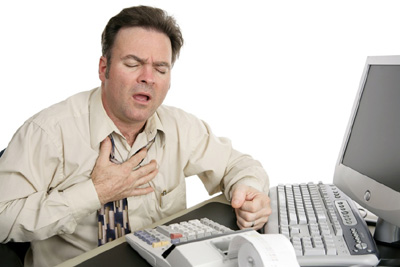Most coronary atherosclerosis develops over many years. Doctors have found the beginnings of plaques in arteries of young soldiers killed in battle. But symptoms seldom occur until age 50 or later, when arteries have narrowed more than 50 percent. In some cases, a heart attack or sudden death occurs in a person who had no previous symptoms. But many people experience an early symptom called angina pectoris, or simply angina. Angina is pain in the chest that happens during exercise or some other activity that makes the heart work harder than usual. Angina occurs because diseased coronary arteries supply the heart with too little oxygen. This lack of oxygen makes the heart muscle hurt during hard work. After the exercise or other activity stops, the pain usually disappears. However, untreated angina may worsen and cause pain even when patients are resting.

Physicians diagnose coronary artery disease by first asking patients about their general physical condition and any past illnesses. The physicians note any risk factors, such as a history of angina or heart attack in the patients or members of their families. Physical examination may reveal additional risk factors, such as high blood pressure or a high cholesterol level.
One of the most useful tools for diagnosing CAD is an instrument called an electrocardiograph. This instrument produces a record called an electrocardiogram (ECG), which displays the electrical activity of the heart muscle. This record is printed on moving paper that shows the electrical activity as a series of wavy lines.
Major waves represent contraction of the ventricles. Minor waves represent relaxation of the ventricles and contraction and relaxation of the atria. Most ECG's are recorded with the patient lying down. However, many physicians take a patient's ECG during exercise. Such a stress ECG shows whether a patient's heart-even if the patient has no chest pain-receives enough oxygen during vigorous exercise.
If your coronary arteries narrow, they can't supply enough oxygen-rich blood to your heart — especially when it's beating hard, such as during exercise. At first, the decreased blood flow may not cause any coronary artery disease symptoms. As the plaques continue to build up in your coronary arteries, however, you may develop coronary artery disease signs and symptoms, including:
- Chest pain (angina). You may feel pressure or tightness in your chest, as if someone were standing on your chest. The pain, referred to as angina, is usually triggered by physical or emotional stress. It typically goes away within minutes after stopping the stressful activity. In some people, especially women, this pain may be fleeting or sharp and felt in the abdomen, back or arm.
- Shortness of breath. If your heart can't pump enough blood to meet your body's needs, you may develop shortness of breath or extreme fatigue with exertion.
- Heart attack. A completely blocked coronary artery may cause a heart attack. The classic signs and symptoms of a heart attack include crushing pressure in your chest and pain in your shoulder or arm, sometimes with shortness of breath and sweating. Women are somewhat more likely than men are to experience less typical signs and symptoms of a heart attack, such as nausea and back or jaw pain. Sometimes a heart attack occurs without any apparent signs or symptoms.
|

